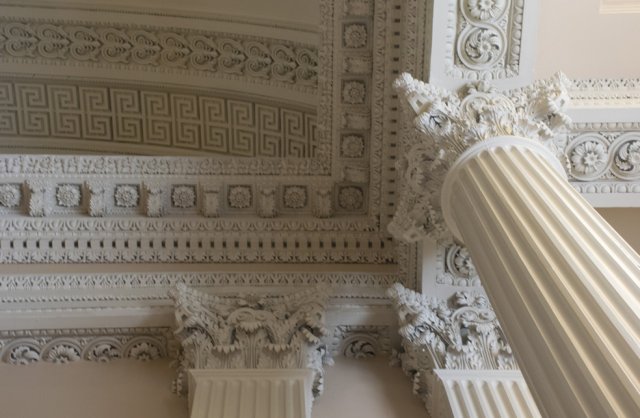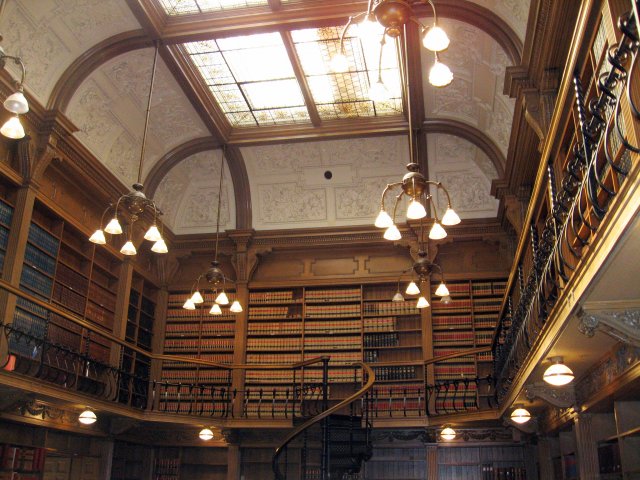“The Library, too, here to be seen, noble in its dimensions and aspect, must, even independently of its contents, tend to create a love of legal study and research.”
Henry Scadding, Toronto of Old in The Canadian Journal of Science, Literature and History, 1873
The word library usually conjures the image of a standalone building dedicated to the lending and enjoyment of books, however today's featured library is just a single room within a building with many different functions. Hidden in plain sight in the heart of downtown Toronto is the Great Library, a magnificent library that Eric Arthur described as “one of the finest in Canada” and which proves that a single room can be as grand as an entire building.
Built to house the Law Society of Upper Canada, the organization responsible for governing Ontario’s lawyers and paralegals, Osgoode Hall has been subject to numerous renovations and additions since its inception in 1829. The Great Library was part of the 1857 renovations to Osgoode Hall, all done under the direction and design of two renowned Toronto architects: William George Storm and Frederick William Cumberland, partners at Cumberland and Storm. Storm would later become the first president of the Ontario Association of Architects while Cumberland would become a member of Ontario’s first two parliaments and a member of the Canadian House of Commons.
While “only a room”, the Great Library was designed to be one of the grandest libraries in North America, and everything in its design, from the room’s proportions to the elaborate ornamentation, were carefully considered to provide this sense of grandeur.

Ornamentation in Osgoode Hall's Great Library. Photo courtesy of J. Squires, 2015.
Upon entering the Great Library, it is the lavish decorations that first capture your eye. While mostly a mix of styles, much of the Great Library follows the conventions of the Corinthian order, one of the three principal classical orders in Greek and Roman architecture. Perfect examples are the tall yet slender fluted columns and pilasters topped by elaborate capitals decorated with acanthus leaves, a telltale characteristic of the Corinthian order. Above them, a highly ornate plaster ceiling showcases elements of Italianate and Renaissance architecture, including coffered vaults and domes adorned with rosettes, and richly decorated moulding. Canadian motifs are also blended into the room’s adornments, including beavers, maple leaves, and the only known example of the arms of Upper Canada.
The eclectic ornamentation extends beyond the columns and ceiling to many other features of the room. To the west end of the library stands a gargantuan ten foot stone fireplace with elaborate baroque elements, including a carved stone mantel and clock and flanking candelabra. Above it hung a baroque mirror which was later replaced by a portrait of Sir John Beverley Robinson.

Photo Credit: City of Toronto Archives, Fonds 1244, Item 2050. (1908)
Another key element to the Great Library’s sense of grandness is its attention to room proportions. Based on the ideas of Palladian architecture and the work of British architect Inigo Jones, cube and double cube proportioned rooms had long become status symbols of many important British buildings, connected to notions of Platonic virtue and purity of form. Cube based rooms were thought to have a greater sense of harmony and proportion, uplifting the spirit and elevating the mind of their users. Referencing the opulence of the European great rooms, Cumberland and Storm crafted the Great Library’s main reading room to be composed of three cubes, each 40’ wide by 40’ long x 40’ feet tall. This attention to pure forms and geometry is expressed elsewhere in the library, including the layout of the central circular dome and the placement of columns and windows.
Beyond its ornamentation and proportions, the Great Library was also designed to host many splendid events. Much like modern libraries, the main reading room was designed to be a multifunctional space, providing not only storage space for books and legal documents but also serving as a banquet room, ballroom or assembly hall when needed. The library has even served to host the bodies of distinguished members of the law profession while lying in state. Key to this flexibility is the library’s layout, with the high oak bookcases placed on the side aisles of the main reading room, while the central nave was left clear with only a few tables which could be easily moved when the room is needed for some other occasion.
Not surprisingly, this grand Canadian library also had a lavish opening held on the evening of September 8, 1860. In attendance at the reception and ball were Edward, the Prince of Wales (later known as King Edward VII), Chief Justice Robinson, the Benchers of the day, and numerous local dignitaries.
In an article published in The Globe on September 10, 1860, it was reported that, “there is not in America a more magnificent building devoted to the law than Osgoode Hall. All that architecture can do to charm the eye or impress the mind with a sense of splendour is there.”

American Room, 2008. Photo Credit: Padraic Ryan.
34 years later…
In 1894, only 34 years after its opening, the Great Library had run out of space and an addition was necessary in order to provide room for the growing collection of American legal documents. Located at the west end of the Great Library and completed in 1895, the American Room was designed by the architecture practice of Burke and Horwood. Following a mandate to maximize wall space and eliminate features that reduced shelf space, the American room features floor to ceiling oak bookshelves which wrap around the entirety of the room. Above, delicately tinted skylights and electrical copper candelabra designed by Edmund Burke was the room with warm light.
While some changes have occurred since its opening in 1860, much of the Grand Library remains untouched. If you wish to visit this majestic Ontario library, the Great Library is open to the public Mon - Fri from 9:00am to 5:00pm or catch a tour during Toronto's annual Doors Open event.
Sources:
Arthur, Eric Ross, and Stephen A. Otto. 2003. Toronto, no mean city. Toronto: Buffalo.
Honsberger, John D. 2004. Osgoode Hall: an illustrated history. Toronto: Dundurn.
Scadding, Henry. 1873. Toronto of Old in The Canadian Journal of Science, Literature and History. Toronto
Brown, Deidré Rowe. Historical Vignettes: The Great Library. The Law Society of Upper-Canada.